Relationship Builder
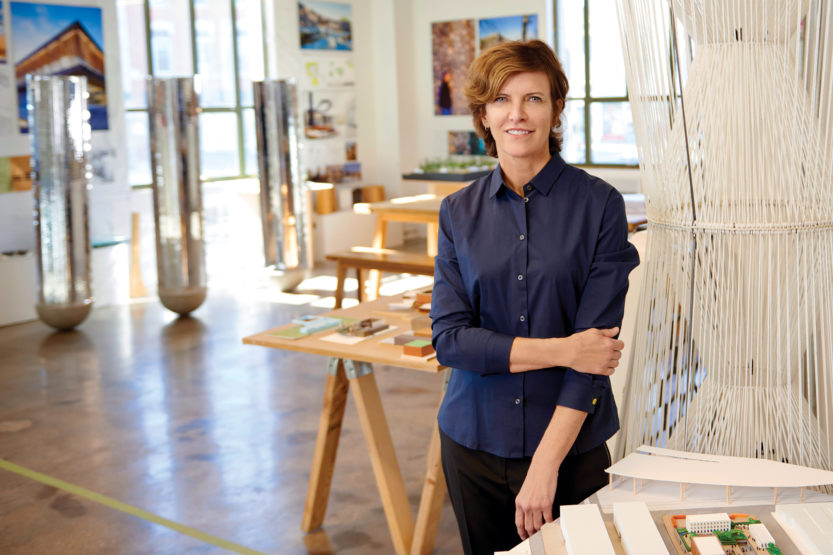 “When I first started out, I kept getting advice from other architects [saying], ‘You have to specialize in something,’” says Jeanne Gang, founding principal of the architecture firm Studio Gang, in her Chicago head-
quarters. “But that’s
not in my DNA.” (Image by Jeff Dahlgren)
“When I first started out, I kept getting advice from other architects [saying], ‘You have to specialize in something,’” says Jeanne Gang, founding principal of the architecture firm Studio Gang, in her Chicago head-
quarters. “But that’s
not in my DNA.” (Image by Jeff Dahlgren) It’s the variety of architect Jeanne Gang’s projects that makes a singular impression, from the rippling balconies of Chicago’s Aqua Tower to the Nature Boardwalk at the city’s Lincoln Park Zoo. There are boathouses along the Chicago River, a new theater in Glencoe, Ill., and a major campus complex in the city’s Hyde Park neighborhood. Soon the Vista Tower will put her soaring stamp on the Chicago skyline.
“When I first started out, I kept getting the same advice from other architects [saying], ‘You have to specialize in something,’” Gang says. “But it’s not in my DNA.”
Going her own way has served Gang ’86 FAA, just fine. It’s tempting to call her the country’s most prominent woman architect, except that would diminish her standing among both men and women. She has won innumerable awards and prizes, including the 2013 National Design Award from the Cooper Hewitt, Smithsonian Design Museum and the 2017 Louis I. Kahn Memorial Award. Architectural Review named her its 2016 Architect of the Year, and she is a MacArthur fellow.
Business, if that’s a useful yardstick, is very good. She heads Studio Gang, a 108-person architectural firm headquartered in Chicago with offices in New York City and San Francisco. The firm’s upcoming projects include major works around the U.S. and abroad.
It is impossible to single out a particular “look” in all this work, or even a trademark style. But Gang definitely has her priorities. Whatever the project, big or small, modest or mega-buck, Gang will stress its human relevance.
“I’m a relationship builder … Most people think architects design buildings and cities, but what we design are relationships,” Gang declared in her 2016 TED talk. “Architects [need to] learn to engage the public in design. They need the engagement of people who live in cities. Cities are where people come together for all kinds of exchanges, but today,” she cautioned, “our urban habitats are out of balance.”
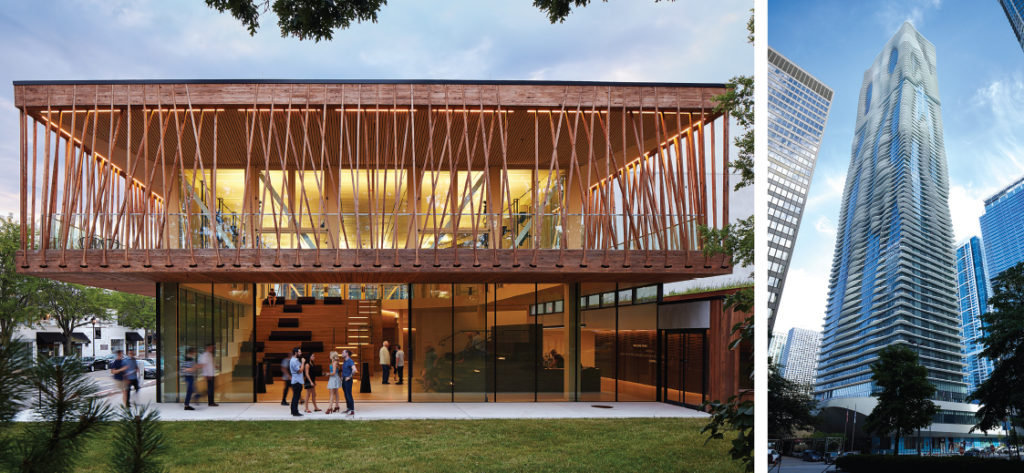
Some notable Studio Gang projects include Writers Theatre in Glencoe, Ill. (left), and the 82-story Aqua Tower in Chicago (right). (Images courtesy of Steve Hall/Hedrich Blessing)
Much of Gang’s design work is aimed at restoring that balance—between people and their environment, and between people and their neighbors. Gang likes the idea of people “bumping into each other.” She believes that architecture should aim to improve social relationships. For instance, Gang transformed a parking lot into a half-court basketball area at a police station in Chicago’s North Lawndale neighborhood, so that the cops could play basketball with local kids.
Her high-rise designs reshaped the conversation about how such buildings could better serve their residents. “When I first started out, there wasn’t a lot of experimentation with towers,” Gang notes. “They were mostly corporate architects taking a commercial approach. Few people thought about how a tower could provide more of a social interaction or impact the environment.” She is not against towers per se, but “they can be isolating.” To combat that, she designed the undulating balconies of the Aqua Tower, an 82-story residential skyscraper in downtown Chicago, so that residents could see each other. Housing facades, Gang suggests, should be more than eye-catching; they can have a functional purpose. “They should be like backyards, where people can wave over fences and say ‘Hi.’”
Studio Gang is swamped with projects. In prioritizing work, she puts materials at the top of her considerations, because materials make a big difference to Gang. “We often explore [their] qualities,” she says. “How wood can be bent, how concrete can be fluid, how steel can be flexible.” And always she asks herself: “What is the building’s purpose? What about this project has the potential to move the needle on certain critical issues—inequality, climate change, ecological diversity and growing populations? What can serve as a model for new ways of living in a city environment?”
Despite the sophistication of her designs—consider the Tour Montparnasse, the tallest skyscraper in Paris, or the Eleanor Boathouse at Park 571 in Chicago—Gang is plainspoken and disarmingly approachable. She comes across as easy to talk to, accessible, and she talks about her work in a straightforward way without pretense or jargon.
“She’s got a Midwestern personality; she’s a good listener, which women tend to be more than men,” says Chicago Tribune architecture critic Blair Kamin. “She’s no diva. But be careful. Jeanne’s not the girl next door who happens to be building 1,200-foot skyscrapers. She’s not from Mayberry; she’s got a lot of Manhattan and Chicago [in her]. She’s fiercely ambitious.”
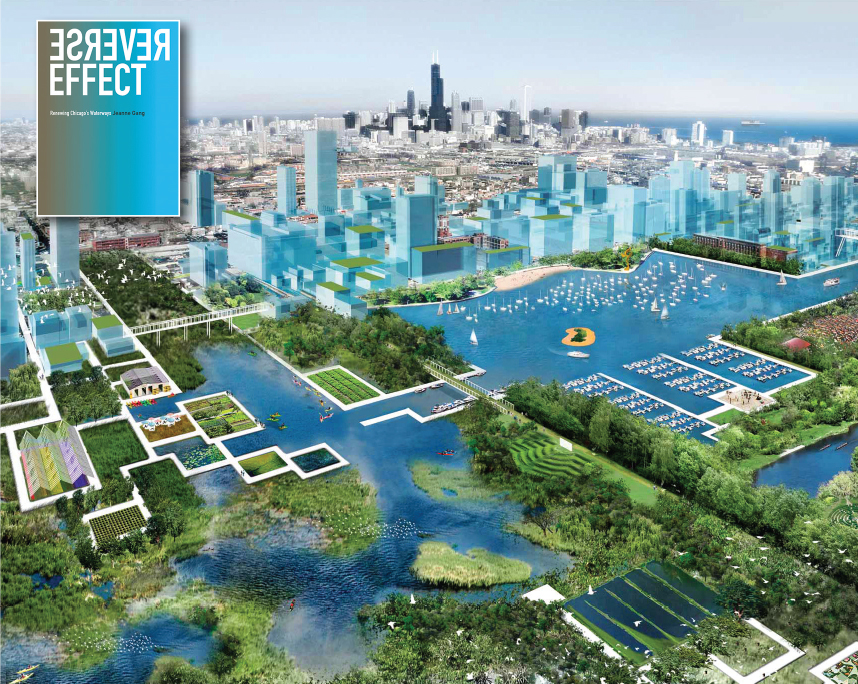
Gang’s 2011 book, “Reverse Effect: Renewing Chicago’s Waterways,” was a clear-eyed imagining of a greener future for the Chicago River, and served as a blueprint for Mayor Rahm Emanuel’s bold redo of the riverbanks as the city’s most exciting new civic space. (Image courtesy of Studio Gang)
It’s tempting to see Gang’s ambition in her most apparent work—the big buildings and towers (Aqua, the Folsom Bay Tower in San Francisco, the striking Solstice on the Park residential building in Hyde Park). But much of her most significant work is closer to the ground—and some of it isn’t even a building. Her 2011 book, Reverse Effect: Renewing Chicago’s Waterways, was a clear-eyed imagining of a greener future for the Chicago River, and served as a blueprint for Mayor Rahm Emanuel’s bold redo of the riverbanks as the city’s most exciting new civic space.
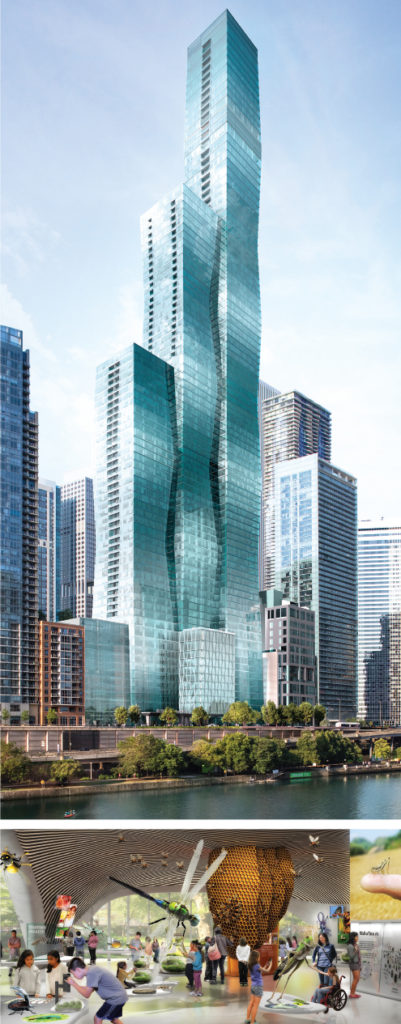
Top: With a height of nearly 1,200 feet, the mixed-use Vista Tower will be the third-tallest skyscraper on Chicago’s skyline. (Image courtesy of Magellan Development Group) Bottom: The Richard Gilder Center for Science, Education and Innovation, American Museum of Natural History in New York City, will include the Insectarium, the institution’s first gallery dedicated to insects in more than 50 years. (Image courtesy of Ralph Applebaum Associates)
Many admirers of her work cite Writers Theatre in Glencoe as one of her most successful projects. The theatre had long ago outgrown the limited space and unremarkable aesthetic of its long-standing home, the Women’s Library Club of Glencoe. Gang created a gleaming glass building with a wood belt that perfectly suited its suburban setting. She designed an airy interior with tiered steps that, like a Greek theatre of yore, promotes community appeal. And she gave it a nighttime lantern-like glow to rival any garish Loop marquee.
“We had submissions from two dozen firms around the country,” says Jon Faris, managing director of Writers Theatre, “and narrowed them down to half a dozen. Those interviews can start to all feel the same, but [Jeanne] was really compelling. She cut right to the chase, listened, and understood exactly who we were and what our identity was.”
The theatre was featured at the Art Institute of Chicago’s exhibition, “Building: Inside Studio Gang Architects,” and was nominated as an Outstanding Project for the 2018 Mies Crown Hall Americas Prize (MCHAP) at the Illinois Institute of Technology.
“[Gang’s] work is very much about how we build, how we make buildings and out of which materials,” says architect Dirk Denison, director of MCHAP. “She brought these multiple elements to Writers Theatre. There was something so unusual about the exterior wood screen. It functions as a railing, but it also supports the floor; it’s structural—and it’s simple.”
Denison is equally enthusiastic about the building’s interior. “It’s performance-based, but it’s also a place to hang out. It’s a post-Rem Koolhaas use of programming as a generator for both form and function.”
Along those lines, one of her most interesting works-in-progress is within the American Museum of Natural History in Manhattan. Gang was hired to design the Richard Gilder Center for Science, Education and Innovation, a major new hub in the museum, which will establish 30 connections across 10 existing buildings with a vitalized central space, while improving traffic flow. The project is a high-profile step for Gang: It carries a hefty price tag, it’s in New York City, where Gang has staffed a busy office, and it represents a landmark in her career.
“In the last 10 years, [Gang] has gone from promising up-and-comer to bona fide star architect,” Kamin says. “But every great architect has to have a museum to his or her credit.”
Immersed in the natural world
But beyond the status of the project, the museum reflects her interest in the natural world, which has intrigued Gang since childhood.
Born in Belvidere, Ill., the daughter of a civil engineer, Gang went on countless road trips in the family station wagon, where she was fascinated by bridges but also filled her suitcase with rocks, pine cones and bird nests. Some of the architectural projects she feels most passionately about are rooted in nature, among them the pavilion at the south end of the Lincoln Park Zoo. Hired to design the facility, she found herself struck by its setting, which was in serious disrepair.
“It was a smelly, broken- down, 19th-century pond, and not the greatest place to be,” Gang says. Consequently, she and the zoo created a team to “think about all aspects of the place—the hydrology, the landscape, the habitat.” Today, the boardwalk she designed, a popular stopover for migratory birds, is a key draw for humans too, and a centerpiece of the zoo’s Urban Wildlife Institute.
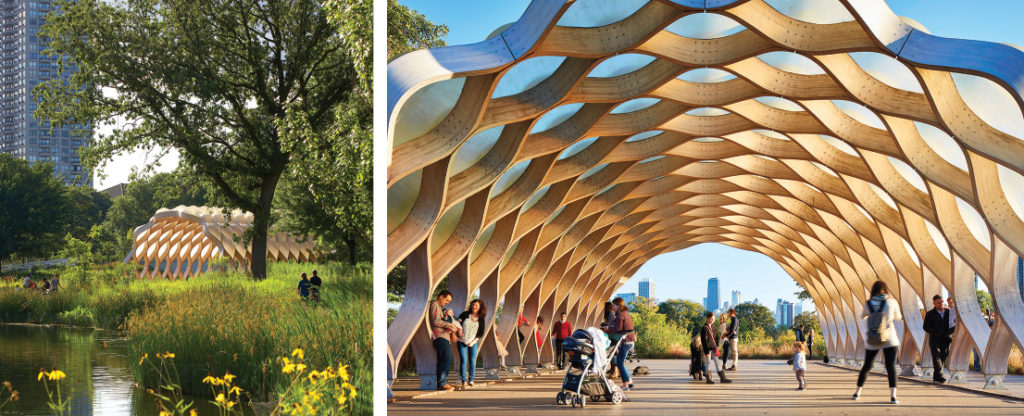
“It was a smelly, broken-down, 19th-century pond, and not the greatest place to be,” says Gang of the South Pond facility at Chicago’s Lincoln Park Zoo. Her design for a Nature Boardwalk improved the area’s water quality, hydrology, landscape and accessibility. The renovation also included a pavilion (right), which provides shelter for open-air classes, programs and events. Left image courtesy of Steve Hall/Hedrich Blessing, and right image courtesy of Tom Harris Photography.
Her father’s profession initially led her to major in engineering at Illinois but she quickly switched to architecture. One of her fondest undergraduate memories is walking past the architecture building at night.
“The lights were always on,” Gang recalls. “We were always recognized for [being the last ones] in our building. It was very special; it was where I experienced the studio culture that so many businesses and business schools are now tapping into. It’s all about creativity and discovering new things through interactions with others.”
That process is very much in evidence in the Studio Gang Chicago offices. Located in a stolid brick building that is the former Polish National Alliance building—and for which Gang worked to get landmark status—the staff is spread over two wide-open, brightly lit floors. In keeping with Gang’s passion for nature, conference rooms are named for trees—Ash, Elm, Oak, Cedar, Cypress. The walls are hung with art, photos and New Yorker magazine covers, and it’s almost impossible to walk through the space without bumping into detailed models of Studio Gang projects—some old, some new or in the works, and not a few that were designed but never built. It’s important, Gang says, to share “the paths not taken, to pass on that knowledge.”
That mélange also is apparent in the designers Gang has hired. Browse the staff directory of the Studio Gang website, and you can’t help but be struck by its diversity and its ranks of designers from around the globe. “Having diversity within a group gives you more of an advantage thinking about a problem in different ways,” Gang says. “Put people who are all the same in a room, and they’re going to come up with the same solution. I look for people who want to go on this journey together.”
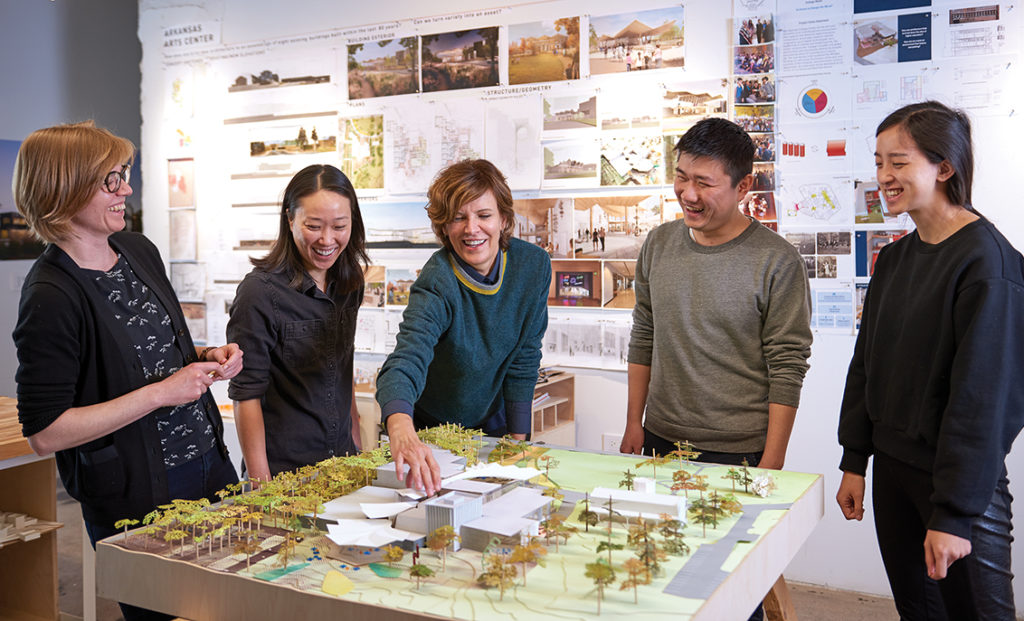
Gang (center) leads a discussion with her Chicago-based design colleagues (left to right): Juliane Wolf, design principal; Angela Peckham, senior project leader; and design team members Peter Yi and Wen Zhou. (Image by Jeff Dahlgren)
There is another kind of interaction here, too—between people and nature. Up on the office roof is an extensive “prairie”—“not just sedum and plant filler,” Gang likes to say—that takes advantage of the city’s bio-diversity. The first year, Gang and her staff planted grain and produced an astonishing 60 pounds of wheat. As the space has matured, plants, shrubs and trees have proliferated. Gang is equally enthused about the garden’s insects and birds, a special interest of hers since she is deeply troubled by the frequency of bird strikes. More than 900 million birds hit buildings across the country every year. In the enclosed space adjoining the garden, Gang uses special fritted glass to alert birds, and so far, none have died.
She is especially proud of her roof, which comes as no surprise. Up on the third floor with its panorama of the neighborhood and the downtown skyline, Gang is most attuned to the context of her work and its impact on the surrounding space, which is mostly urban. “We are always pushing to see how cities can incorporate advanced ideas of bio-diversity and ecosystems,” she says. “We now see cities as alive and breathing. It’s what interests me about architecture—its power to explore new things about cities, people and nature.”

